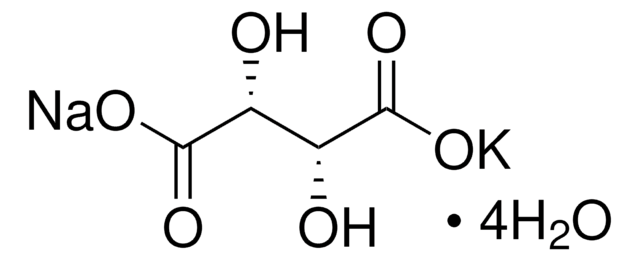Key Documents
C1297
Copper(II) sulfate
ReagentPlus®, ≥99%
Synonim(y):
Cupric sulfate
About This Item
Polecane produkty
ciśnienie pary
7.3 mmHg ( 25 °C)
Poziom jakości
linia produktu
ReagentPlus®
Próba
≥99%
Postać
powder
przydatność reakcji
reaction type: click chemistry
pH
3.5-4.5 (20 °C, 50 g/L)
mp
200 °C (dec.) (lit.)
gęstość
3.603 g/mL at 25 °C (lit.)
temp. przechowywania
room temp
ciąg SMILES
[Cu++].[O-]S([O-])(=O)=O
InChI
1S/Cu.H2O4S/c;1-5(2,3)4/h;(H2,1,2,3,4)/q+2;/p-2
Klucz InChI
ARUVKPQLZAKDPS-UHFFFAOYSA-L
Szukasz podobnych produktów? Odwiedź Przewodnik dotyczący porównywania produktów
Opis ogólny
Zastosowanie
- Alcoholysis of wheat straw into methyl levulinate.
- Selective oxidation of amines to imines in the presence of hydrogen peroxide as an oxidant.
- Synthesis of 1,2,3-triazoles via Click reactions of azides and alkynes.
- Microwave-assisted Huisgen-type cycloaddition to synthesize modified poly(N-vinylpyrrolidone).
Informacje prawne
Hasło ostrzegawcze
Warning
Zwroty wskazujące rodzaj zagrożenia
Zwroty wskazujące środki ostrożności
Klasyfikacja zagrożeń
Acute Tox. 4 Oral - Aquatic Acute 1 - Aquatic Chronic 1 - Eye Irrit. 2 - Skin Irrit. 2
Kod klasy składowania
11 - Combustible Solids
Klasa zagrożenia wodnego (WGK)
WGK 3
Temperatura zapłonu (°F)
Not applicable
Temperatura zapłonu (°C)
Not applicable
Certyfikaty analizy (CoA)
Poszukaj Certyfikaty analizy (CoA), wpisując numer partii/serii produktów. Numery serii i partii można znaleźć na etykiecie produktu po słowach „seria” lub „partia”.
Masz już ten produkt?
Dokumenty związane z niedawno zakupionymi produktami zostały zamieszczone w Bibliotece dokumentów.
Klienci oglądali również te produkty
Nasz zespół naukowców ma doświadczenie we wszystkich obszarach badań, w tym w naukach przyrodniczych, materiałoznawstwie, syntezie chemicznej, chromatografii, analityce i wielu innych dziedzinach.
Skontaktuj się z zespołem ds. pomocy technicznej








![Tris[(1-benzyl-1H-1,2,3-triazol-4-yl)methyl]amine 97%](/deepweb/assets/sigmaaldrich/product/structures/179/695/86a721c8-2a4c-4e4f-bc36-6276ce7a941f/640/86a721c8-2a4c-4e4f-bc36-6276ce7a941f.png)